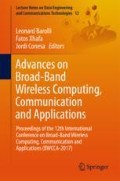Abstract
The opportunistic networks are the variants of Delay Tolerant Networks (DTNs). These networks can be useful for routing in places where there are few base stations and connected routes for long distances. In an opportunistic network, when nodes move away or turn off their power to conserve energy, links may be disrupted or shut down periodically. These events result in intermittent connectivity. When there is no path existing between the source and the destination, the network partition occurs. Therefore, nodes need to communicate with each other via opportunistic contacts through store-carry-forward operation. In this work, we consider the IoT device selection problem in opportunistic networks and we propose and implement two Fuzzy Based Systems (FBS): FBS1 and FBS2 for IoT Device Selection in Opportunistic Networks. We evaluate the performance of the proposed system by simulations. We evaluated the proposed systems by computer simulations. Comparing FBS1 with FBS2, the FBS2 is more complex than FBS1, because it has more rules in FRB, but using FBS2 a better actor node can be selected, because the IDST is high.
Access this chapter
Tax calculation will be finalised at checkout
Purchases are for personal use only
References
Kraijak, S., Tuwanut, P.: A survey on internet of things architecture, protocols, possible applications, security, privacy, real-world implementation and future trends. In: IEEE 16th International Conference on Communication Technology (ICCT), pp. 26–31. IEEE (2015)
Dhurandher, S.K., Sharma, D.K., Woungang, I., Bhati, S.: Hbpr: history based prediction for routing in infrastructure-less opportunistic networks. In: IEEE 27th International Conference on Advanced Information Networking and Applications (AINA), pp. 931–936. IEEE (2013)
Akbas, M., Turgut, D.: Apawsan: Actor positioning for aerial wireless sensor and actor networks. In: IEEE 36th Conference on Local Computer Networks (LCN-2011), pp. 563–570, October 2011
Akbas, M., Brust, M., Turgut, D.: Local positioning for environmental monitoring in wireless sensor and actor networks. In: IEEE 35th Conference on Local Computer Networks (LCN-2010), pp. 806–813, October 2010
Melodia, T., Pompili, D., Gungor, V., Akyildiz, I.: Communication and coordination in wireless sensor and actor networks. IEEE Trans. Mobile Comput. 6(10), 1126–1129 (2007)
Inaba, T., Sakamoto, S., Kolici, V., Mino, G., Barolli, L.: A CAC scheme based on fuzzy logic for cellular networks considering security and priority parameters. In: The 9th International Conference on Broadband and Wireless Computing, Communication and Applications (BWCCA-2014), pp. 340–346 (2014)
Spaho, E., Sakamoto, S., Barolli, L., Xhafa, F., Barolli, V., Iwashige, J.: A fuzzy-based system for peer reliability in JXTA-Overlay P2P considering number of interactions. In: The 16th International Conference on Network-Based Information Systems (NBiS-2013), pp. 156–161 (2013)
Matsuo, K., Elmazi, D., Liu, Y., Sakamoto, S., Mino, G., Barolli, L.: FACS-MP: a fuzzy admission control system with many priorities for wireless cellular networks and its performance evaluation. J. High Speed Netw. 21(1), 1–14 (2015)
Grabisch, M.: The application of fuzzy integrals in multicriteria decision making. Eur. J. Oper. Res. 89(3), 445–456 (1996)
Inaba, T., Elmazi, D., Liu, Y., Sakamoto, S., Barolli, L., Uchida, K.: Integrating wireless cellular and Ad-Hoc networks using fuzzy logic considering node mobility and security. In: The 29th IEEE International Conference on Advanced Information Networking and Applications Workshops (WAINA-2015), pp. 54–60 (2015)
Kulla, E., Mino, G., Sakamoto, S., Ikeda, M., Caballé, S., Barolli, L.: FBMIS: a fuzzy-based multi-interface system for cellular and Ad Hoc networks. In: International Conference on Advanced Information Networking and Applications (AINA-2014), pp. 180–185 (2014)
Elmazi, D., Kulla, E., Oda, T., Spaho, E., Sakamoto, S., Barolli, L.: A comparison study of two fuzzy-based systems for selection of actor node in wireless sensor actor networks. J. Ambient Intell. Humanized Comput. 6(5), 635–645 (2015)
Zadeh, L.: Fuzzy logic, neural networks, and soft computing. ACM Commun. 37, 77–84 (1994)
Spaho, E., Sakamoto, S., Barolli, L., Xhafa, F., Ikeda, M.: Trustworthiness in P2P: performance behaviour of two fuzzy-based systems for JXTA-overlay platform. Soft Comput. 18(9), 1783–1793 (2014)
Inaba, T., Sakamoto, S., Kulla, E., Caballe, S., Ikeda, M., Barolli, L.: An integrated system for wireless cellular and Ad-Hoc networks using fuzzy logic. In: International Conference on Intelligent Networking and Collaborative Systems (INCoS-2014), pp. 157–162 (2014)
Matsuo, K., Elmazi, D., Liu, Y., Sakamoto, S., Barolli, L.: A multi-modal simulation system for wireless sensor networks: a comparison study considering stationary and mobile sink and event. J. Ambient Intell. Humanized Comput. 6(4), 519–529 (2015)
Kolici, V., Inaba, T., Lala, A., Mino, G., Sakamoto, S., Barolli, L.: A fuzzy-based CAC scheme for cellular networks considering security. In: International Conference on Network-Based Information Systems (NBiS-2014), pp. 368–373 (2014)
Liu, Y., Sakamoto, S., Matsuo, K., Ikeda, M., Barolli, L., Xhafa, F.: A comparison study for two fuzzy-based systems: improving reliability and security of JXTA-overlay P2P platform. Soft Comput. 20(7), 2677–2687 (2015)
Mendel, J.M.: Fuzzy logic systems for engineering: a tutorial. Proc. IEEE 83(3), 345–377 (1995)
Acknowledgement
This research is partially supported by The Telecommunications Advancement Foundation (TAF). The first author would like to thank TAF for the financial support.
Author information
Authors and Affiliations
Corresponding author
Editor information
Editors and Affiliations
Rights and permissions
Copyright information
© 2018 Springer International Publishing AG
About this paper
Cite this paper
Cuka, M., Elmazi, D., Oda, T., Kulla, E., Ikeda, M., Barolli, L. (2018). Effect of Storage Size on IoT Device Selection in Opportunistic Networks: A Comparison Study of Two Fuzzy-Based Systems. In: Barolli, L., Xhafa, F., Conesa, J. (eds) Advances on Broad-Band Wireless Computing, Communication and Applications. BWCCA 2017. Lecture Notes on Data Engineering and Communications Technologies, vol 12. Springer, Cham. https://doi.org/10.1007/978-3-319-69811-3_9
Download citation
DOI: https://doi.org/10.1007/978-3-319-69811-3_9
Published:
Publisher Name: Springer, Cham
Print ISBN: 978-3-319-69810-6
Online ISBN: 978-3-319-69811-3
eBook Packages: EngineeringEngineering (R0)

